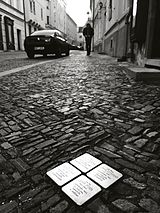List of memorial stones for Nazi victims in Brno
The list of memorial stones for Nazi victims in Brno contains memorial stones that were laid in Brno (Czech: Brno), the capital of the Czech region Jihomoravský kraj (South Moravian Region), next to the stumbling blocks in Brno . They commemorate the fate of people from Brno who were murdered, deported, expelled or driven to suicide by the National Socialists .
The memorial stones are based on the stumbling blocks laid by Gunter Demnig in many places and were mostly laid by the Brno Sokol woman. They differ from the Stolpersteine in at least two ways: They are significantly larger (approx. 20 × 20 cm) and the inscriptions were not made by hand.
The memorial stones for Vojtěch Beneš and Ludvík Makele, first relocated in 2015, were relocated to a different address on June 27, 2016.
Brno
| image | Surname | Location | Life |
|---|---|---|---|

|
Vojtěch Beneš | Pisárecká 1 |
Vojtěch Beneš was born on August 4, 1892 in Letovice . He studied at the Technical University of Brno at the Institute of Cultural Engineering. From 1920 to 1921 he worked for the Moravia farm, then until 1922 for the Brno City Building Authority. In 1923 he became head of the Brno waterworks. On September 1, 1939, he was arrested as part of the Albrecht I campaign and initially held in the Spielberg Fortress prison . He was then deported to Dachau concentration camp and then to Buchenwald concentration camp . On November 4, 1942, he was sentenced to five years in prison by the People's Court in Breslau . His wife Božena Benešová received notification that her husband had died on November 11, 1943 in the Hohenasperg fortress in the department for tuberculosis and cardiac insufficiency. |

|
Heinrich Blum | Veveří 77 | |

|
Arnošt Bondy | Cejl 17 | |
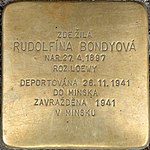
|
Rudolfína Bondyová | Cejl 17 | |
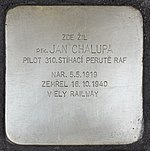
|
Jan Chalupa | Veveří 14 | |

|
Dorrit Fischer | Veveří 52 | |

|
František Geisler | Veveří 75 | |
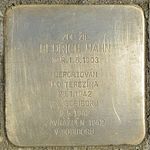
|
Bedrich Hahn | Grohova 51 | |

|
Gustav Hahn | Grohova 51 | |

|
Hermína Hahnová | Grohova 51 | |

|
Ladislav Jandásek | Soukopova 529/4 |
Ladislav Jandásek was born on November 19, 1887 in Moravany u Kyjova . He studied Czech and French at Charles University in Prague , graduating in 1910 and becoming a teacher. In 1921 he married Bozena, nee Kubiková, the couple had two children - Jamila (born 1922) and Miroslav (born 1923). In 1938 Jandásek was appointed school inspector. He was a member of Sokols Brno I and was very active here. He worked as the editor of the writings of the Sokol co-founder Miroslav Tyrš and wrote about the history of Sokol himself. He also joined the Obrana národa resistance group . He was arrested in 1940, released, and finally arrested again in 1941 and deported to Auschwitz , where he died on September 5, 1942. |

|
Čestmír Jelinek | Domažlická 10 | |

|
Pavel Jeral | Lidická 14 |
Pavel Jeral was born on July 15, 1890 in Mladá Boleslav . He was trained at the Prague Conservatory , from 1919 he was a permanent member of the Brno Opera House, in 1924/1925 he was engaged at the Saarbrücken State Theater . In 1925 he became cantor of the synagogue in Brno and from 1925 to 1942 a singing teacher. On March 29, 1942, after his arrest, he was deported from Brno to the Theresienstadt concentration camp on Transport Ae (his number on the transport was 561) . From there he was probably transferred to Lublin on May 25, 1942 with Transport Az (his number on the transport was 742) . His wife Margit, née Klein, and his two children Sylva (born 1924) and Richard (born 1927) were deported with him. They did not survive the Shoah . |

|
Richard Jeral | Lidická 14 |
Richard Jeral was born in Brno on December 20, 1927. He was the son of the opera singer Pavel Jeral and his wife Margit Jeralová. He had an older sister - Sylva, born in 1924. On March 29, 1942, he and his parents and sister were deported from Brno to the Theresienstadt concentration camp on Transport Ae . From there he was transferred to Lublin on May 25, 1942, again together with his family, on Transport Az . Richard Jeral and his family did not survive the Shoah . |

|
Margita Jeralová (née Klein) |
Lidická 14 |
Margita Jeralová, née Klein, was born on April 19, 1896 in Brno. She was married to the opera singer Pavel Jeral . She had two children with him - Sylva, born in 1924 and Richard, born in 1927. On March 29, 1942, she and her husband and children were deported from Brno to the Theresienstadt concentration camp on Transport Ae (her number on the transport was 562) . From there, together with her family, she was transferred to Lublin on May 25, 1942 with Transport Az (her number on the transport was 741) . Margita Jeralová and her family did not survive the Shoah . |

|
Sylva Jeralová | Lidická 14 |
Sylva Jeralová was born on June 13, 1924. She was the oldest child of the opera singer Pavel Jeral and his wife Margita. She had a younger brother - Richard, born in 1927. On March 29, 1942, she and her parents and brother were deported from Brno to the Theresienstadt concentration camp on Transport Ae (her number on the transport was 563) . From there, together with her family, she was transferred to Lublin on May 25, 1942 with Transport Az (her number on the transport was 744) . Sylva Jeralová and her family did not survive the Shoah . |

|
Alois Jiří Kirschner | Střední 15/398 |
Alois Jiří Kirschner was born on March 23, 1934. His parents were Walter Kirschner and Frieda Kirschnerová. He had a sister born in 1932 - Zuzanna. On April 4, 1942, he was deported from Brno to the Theresienstadt ghetto with his mother, sister Zuzanna and other family members on Transport Ah (his number on the transport was 334) . On May 9, 1942, he was transferred to the Osowa labor camp near Sobibor on Transport Ax (his number on the transport was 757) . He was murdered by the Nazi regime in an unknown location. |

|
Cecilie Kirschnerová (nee Sinaibergerová) |
Střední 15/398 |
Cecilie Kirschnerová, nee Sinaibergerová, was born on February 20, 1864 in Ivančice. She was married to Alois Kirschner, the couple had at least two sons - Hugo, born in 1886, and Walter. Her husband died in 1933. On April 4, 1942, she and her son and other members of her family were deported from Brno to the Theresienstadt ghetto on Transport Ah (her number on the transport is 335) . According to the issued death certificate, Cecilie Kirschnerová died here on September 6, 1942 of pulmonary edema . Her son Hugo was transferred to Auschwitz in October 1944, and their son Walter was also deported. Neither of them survived the Shoah .
The report to Yad Vashem for Cecilie Kirschnerová was made by Hugo's only surviving daughter - Renée Skalová. She too had been deported to Theresienstadt, but was not transferred to the Osowa labor camp like the rest of the family. She lived in Prague after the war and became the mother of two daughters. She died in 2012. |

|
Frieda Kirschnerová (nee Pretzner) |
Střední 15/398 |
Frieda Kirschnerová, nee Pretzner, was born on April 14, 1908. She was married to Walter Kirschner. The couple had a son - Alois Jiří Kirschner, born in 1934 and a daughter - Zuzana, born in 1932. She and her children and other family members were brought from Brno on April 4, 1942 with Transport Ah (her number on the transport was 764) deported to the Theresienstadt ghetto . On May 9, 1942, she was transferred to the Osowa labor camp near Sobibor on Transport Ax (her number on the transport was 758) . She was murdered by the Nazi regime in an unknown location. |

|
Zuzana Kirschnerová | Střední 15/398 |
Zuzana Kirschnerová was born on August 2, 1932 in Brno. Her parents were Walter Kirschner and Frieda Kirschnerová. She had a younger brother, Alois Jiří (born 1934). On April 4, 1942, she was deported from Brno to the Theresienstadt ghetto with her parents, brother and other family members on Transport Ah (her number on the transport was 333) . On May 9, 1942, she was transferred to the Osowa labor camp near Sobibor on Transport Ax (her number on the transport was 756) . None of the 999 deported Jews survived the Shoah . Zuzana Kirschnerová was also murdered by the Nazi regime. |

|
Zdeněk Krejčí | Sedlákova 51/525 |
Zdeněk Krejčí was born on November 4, 1903 in Prague in the Vinohrady district. He came to Brno in 1920 because his father, Prof. JUDr. Dobroslav Krejčí received a professorship in statistics at Masaryk University . Zdeněk Krejčí studied law at Masaryk University , in 1926 he passed his state examination. He worked for a bank and was a member of Sokol Brno I. On September 1, 1939, he was arrested for his work with Sokol in the Albrecht I action and imprisoned in the Spielberg fortress until November 11, 1939 . He was arrested again on September 30, 1941. He came to the Gestapo - Prison Pod Kaštany . From there he was transferred to Auschwitz. His wife, Marie Krejčí, was finally told that Zdeněk Krejčí had died of degeneration of the heart muscle. He left two children, Zdeňka and Jaroslav.
His name is commemorated on a plaque for the victims of the Second World War in Bank Rooseveltova 18/01 in Brno, as well as on a plaque for the victims of the occupation among the members of Sokol Brno I at Kounicova 20-22 / 01. |

|
Josef Kudela | Klácelova 10 | |

|
Friedrich Lampl | Mášova 6/724 |
Friedrich (Bedřich) Lampl was born on May 10, 1889 in Holešov . On January 10, 1937, he married Hedvika, nee Kammerer. On December 5, 1941, he and his wife were deported from Brno to the Theresienstadt concentration camp on Transport K (his number on the transport was 815) . From there he was transferred to Riga on December 5, 1941, again with his wife, on Transport P (his number on the transport was 497) . Bedřich Lampl and his wife did not survive the Shoah .
His sister Olga, married Huber, was also murdered in Auschwitz in 1944. |

|
Hedvika Lamplová (nee Kammerer) |
Mášova 6/724 |
Hedvika Lamplová (also Hedvig Lampel), née Kammerer, was born on July 13, 1900 in Vienna . She married Bedřich Lampl on January 10, 1937. On December 5, 1941, she and her husband were deported from Brno to the Theresienstadt concentration camp on Transport K (her number on the transport was 814) . From there she was transferred to Riga on December 5, 1941, again together with her husband, on Transport P (her number on the transport was 496). Hedvika Lamplová and her husband did not survive the Shoah . |

|
Oskar Löffler | Radnická 10 | |

|
Marta Löfflerová | Radnická 10 | |

|
Ludvík Mackerle | Pisárecká 1 |
Ludvík Mackerle (his name is spelled Mackrle in some places) was born on August 8, 1893 in Biskupice u Jevíčka. From 1911 to 1915 he studied cultural engineering at the Technical University of Brno . During the First World War he fought in the 93rd Infantry Regiment of the Austro-Hungarian Army . He was captured in 1916. In 1921 he was able to finish his studies that had been interrupted by the war. He became the deputy director of the Brno waterworks. After the occupation of the Czech Republic , he joined the resistance group Obrana národa ( Defender of the Nation ). He was arrested for this on January 29, 1940 and was taken to Sušilovy koleje , a former student residence that had been used by the German criminal police since 1940. Then he was taken to a prison in Wroclaw . On November 4, 1942, he was sentenced to seven years in prison. He was incarcerated in prisons in Dietz and Brieg. On June 28, 1943 he was killed in prison in Brzeg. He was a member of Sokol Brno I.
He is remembered on several memorial plaques in Brno. So on the memorial plaque for the victims of the 2nd World War among the employees of the city administration and the members of the diplomatic corps in the 1st courtyard of the New Town Hall, for the victims of the occupation among the members of Sokol Brno I in Kounicova 20-22 / 01 as well as for the victims of the Second World War among the employees of the waterworks at the waterworks building. |

|
Pravoslav Navrátil | Grohova 63 | |

|
Karel Schimmerling | Botanická 612/36 |
Karel (Carl) Schimmerling was born on October 8, 1886 in Brno. He was married to Růžena Schimmerlingová, nee Ippen. The couple had two children - their son Hanuš, born on March 30, 1921, and their daughter Doris, born in Jihlava in 1926. After the smashing of the rest of the Czech Republic in 1939, daughter Doris was no longer allowed to attend the Czech school and went to a Jewish high school for six months until this was no longer possible. The entire family had to leave the apartment and moved to a more simply furnished part of the city. On January 28, 1942, the family had to go to a school at 37 Merhautova Street. From this collection point they were deported to the Theresienstadt concentration camp on Transport U (this was the third transport from Brno to Theresienstadt) (Karel's number on this transport was 57). On October 16, 1944, Karel was deported to Auschwitz together with his son Hanuš; his prisoner number on the transport was 1275. His wife Růžena was murdered in Theresienstadt in February 1944. Daughter Doris stayed in Theresienstadt. The transport reached Auschwitz on October 28, 1944, where Karel was murdered.
Karel's children survived the Holocaust. Hanuš founded the Theresienstadt Initiative , married and had one child. He died in Prague on April 26, 1999. Daughter Doris (now married Grozdanovičová) studied in Brno, then worked in the Ministry of Foreign Affairs of Czechoslovakia in Prague. She lost this job when an aunt emigrated to England. She then worked in a printing company and became an editor at a publishing house. In the 1980s, she was forced to retire because her son did not return from a stay in England. She is editor of the newspaper of the Theresienstädter Initiative and active as a contemporary witness. |

|
Růžena Schimmerlingová (nee Ippenová) |
Botanická 612/36 |
Růžena Schimmerlingová, nee Ippenová, was born on October 23, 1893. She was married to Karel (Carl) Schimmerling. The couple had two children - their son Hanuš, born on March 30, 1921, and their daughter Doris, born in Jihlava in 1926. After the smashing of the rest of the Czech Republic in 1939, daughter Doris was no longer allowed to attend the Czech school and went to a Jewish high school for six months until this was no longer possible. The entire family had to leave the apartment and moved to a more simply furnished part of the city. On January 28, 1942, the family had to go to a school at 37 Merhautova Street. From this collection point they were deported to the Theresienstadt concentration camp on Transport U (this was the third transport from Brno to Theresienstadt) (Růžena number on this transport was 58). On February 20, 1944, Růžena Schimmerlingová was murdered in Theresienstadt.
In October 1944 her husband and son Hanuš were deported to Auschwitz. Karel Schimmerling was murdered there. Růžena's mother Arnoštka Ippenová was also deported to Theresienstadt concentration camp in March 1942, where she was murdered in April 1942. Karel's children survived the Holocaust. Hanuš founded the Theresienstadt Initiative , married and had one child. He died in Prague on April 26, 1999. Daughter Doris (now married Grozdanovičová) studied in Brno, then worked in the Ministry of Foreign Affairs of Czechoslovakia in Prague and then in a printing company and became the editor of a publishing house. She was forced into retirement in the 1980s. She is editor of the newspaper of the Theresienstädter Initiative and active as a contemporary witness. |

|
Leontina Schönhauserová (née Kaufmannová) |
Třída Kapitána Jaroše 37 |
Leontina Schönhauserová, née Kaufmannová, was born on April 6, 1877, she was married to Max Schönhauser. The couple had a daughter - Olga (born in 1907). Max died in 1941. On March 31, 1942, she was deported from Brno to Theresienstadt on Transport Af (her prisoner number on this transport was 552). From here she was deported to Lublin on April 23, 1942 with Transport Al (her number on this transport was 682). Leontina Schönhauserová was murdered here that same year.
Daughter Olga was deported a few days to Leontina together with her husband and two daughters (first to Theresienstadt, 1944 to Auschwitz). Only daughter Gerta Renné was not deported to Auschwitz and survived the Shoah . |
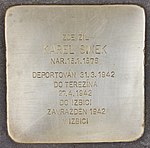
|
Karel Sinek | Mášova 23a | |

|
Hilda Sinková | Mášova 23a | |

|
Karel Tomeš | Tomešova 6/568 |
|

|
Josef Tvrdý | Tvrdého 8/564 |
Josef Tvrdý was born on September 19, 1877 in Tuř u Jičína , he studied classical philology , philosophy and French at the Charles University . In 1901 he became a teacher at a grammar school in Vyškově. He joined the Česká strana státoprávně pokroková , the Czech progressive constitutional party, and the Sokol gymnastics movement . During the First World War he worked as an officer in the health services, after which he taught in Brno. In 1920 he received his doctorate in philosophy, and two years later he received his habilitation . In 1927 he became associate professor at the Comenius University in Bratislava, 1930 full professor, 1932/1933 dean. He also taught at Masaryk University in Brno and was head of the State Pedagogical Academy from 1931 to 1939. In 1938 he received a professorship at Masaryk University and ended his activity in Bratislava. In December 1941 he was arrested by the Gestapo and imprisoned in the Kounicovy koleje, a Gestapo prison and execution site. He was deported to Mauthausen concentration camp , where he was given the number 1218. On his death certificate, May 13, 1942 was noted as the date of his death. |

|
František Wenzl | Mášova 21 | |
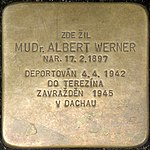
|
Albert Werner | Joštova 3 | |
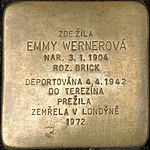
|
Emmy Wernerová | Joštova 3 | |

|
Heda Wernerová | Joštova 3 | |

|
Ella Zeislová | Veveří 52 | |

|
Eugene Zeisel | Veveří 52 |
Relocations in 2016
Eleven more memorial stones were laid in 2016:
- Mášova 21: Ing.Fantišek Wenzl, Dr. hc
- Mášova 23a: Karel and Hilda Sinek
- Veveří 14: plk. Jan Chalupa
- Grohova 51: Gustav Hahn, Bedřich Hahn and Hermína Hahnová
- Grohova 63: pplk. Pravoslav Navrátil
- Wurmova 4: poor. gen. Vojtěch Boris Luža
- Klácelova 10: PhDr. Josef Kudela
- Domažlická 10: pplk. Čestmír Jelínek
Laying data
The memorial stones were laid on the following days:
- September 10, 2015; Botanická 36/612, Jaroše 37, Sedlákova 51/525, Soukopova 4/529
- October 15, 2015: Lidická 14, Mášova 6/724, Střední 15/398
- June 27, 2016: Pisárecká 1
The two memorial stones for Vojtěch Beneš and Ludvík Mackerle were first relocated on September 10, 2015 in Pisárecká 10/272 and relocated on June 27, 2016 at Pisárecká 1.
swell
- Holocaust.cz , Czech Holocaust database (German version)
Web links
Individual evidence
- ↑ Stolpersteine a Sokol Brno I , report of the press agency ČTK , online at: www.protext.cz/
- ↑ Kameny zmizelých připomenou dalších čtrnáct obětí holocaustu , report from the station Česká televize, online at: ceskatelevize.cz / ...
- ^ Project Stolpersteine (Kameny zmizelých) Brno , report of the association of July 19, 2013, online at: sokol.cz/
- ↑ Vojtěch Beneš , biography, In: Encyclopedia of the History of the City of Brno (Czech)
- ↑ Ladislav Jandásek , biography, In: Encyclopedia of the History of the City of Brno (Czech)
- ↑ Národní divadlo : Pavel Jeral , short biography (Czech)
- ^ Yad Vashem - Central Database of the Names of the Holocaust Victims - Richard Jeral. Retrieved December 15, 2016 .
- ^ Yad Vashem - Central Database of the Names of Holocaust Victims - Margita Jeralová. Retrieved December 15, 2016 .
- ^ Yad Vashem - Central Database of the Names of the Holocaust Victims - Sylva Jeralová. Retrieved December 15, 2016 .
- ↑ Alois Jiří Kirschner , biography, In: Encyclopedia of the History of the City of Brno (Czech)
- ↑ Holocaust.cz - Kirschnerová Cecilie: Death certificate, Ghetto Terezín. Retrieved December 15, 2016 .
- ^ Yad Vashem - Central Database of the Names of the Holocaust Victims - Cecilie Kirschnerová. Retrieved December 15, 2016 .
- ^ Yad Vashem - Central Database of the Names of the Holocaust Victims - Frieda Kirschnerová. Retrieved December 15, 2016 .
- ↑ holocaust.cz: TRANSPORT AX (May 9, 1942 THERESIENSTADT -> SOBIBÓR, OSSOWA) , accessed on May 12, 2017
- ↑ Zuzana Kirschner , biography, In: Encyclopedia of the History of the City of Brno (Czech)
- ↑ a b JUDr. Zdeněk Krejčí , biography, In: Encyclopedia of the History of the City of Brno (Czech)
- ↑ Encyklopdie Dejin mesta Brna - Friedrich Lampel. Retrieved December 15, 2016 .
- ↑ Encyclopedia dejin mesta Brna - Hedvika Lamplová. Retrieved December 15, 2016 .
- ↑ Sborník: Bulletin 1951 / 1-2, p 128
- ↑ a b Ing. Ludvík Mackerle , biography, In: Encyclopedia of the History of the City of Brno (Czech)
- ↑ Holocaust.cz - Karel Schimmerling
- ↑ a b biography of Doris Grozdanovičová
- ^ Holocaust.cz Růžena Schimmerlingová
- ↑ Holocaust.cz Arnoštka Ippenová
- ^ Biography Doris Grozdanovičová
- ↑ Max Schönhauser
- ^ Holocaust.cz - Leontina Schönhauserová
- ^ Yad Vashem - Leontina Schönhauserová
- ↑ Olga Kirschner
- ↑ Hugo Kirschner
- ↑ Eva Liane Kirschner
- ↑ Gerta Renné Skálová
- ↑ Nikolaus Lobkowicz : Marxism-Leninism in the ČSR: The Czechoslovakian Philosophy Since 1945, Reidel, Dordrecht 1961, ISBN 90-277-0058-3 , p. 215
- ↑ ŽIDOVSKÁ OBEC BRNO: Kameny zmizelých (stumbling blocks) , accessed on March 5, 2017


